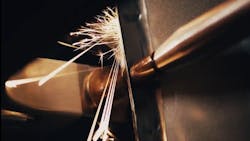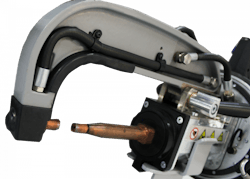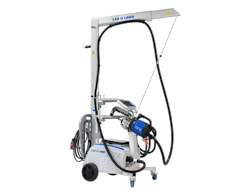Guest Blog: Meeting the challenges of evolving materials with advanced technology welders
The automotive industry continues to evolve, building on high-strength steel (HSS) and ultra-high-strength steel (UHSS) to now include multi-material designs and lightweight alloys. HSS remains vital for safety and performance, but today’s vehicles increasingly combine it with aluminum, composites, and advanced joining techniques to boost fuel efficiency and support electrification. These materials pose unique repair and welding challenges, requiring advanced technology to maintain structural integrity and meet Original Equipment Manufacturer (OEM) standards.
High-strength steels offer a superior strength-to-weight ratio, enabling lighter, safer vehicles. However, its hardness complicates repairs, especially welding, where traditional methods risk weak welds or heat damage. When welding high-strength steel, technicians must account for the material’s specific properties to avoid compromising the vehicle’s structural integrity. Today’s repair challenges, however, extend beyond welding high-strength steel alone. Technicians must now address multi-material joints (balancing heat for HSS and aluminum), electrification needs (protecting EV battery enclosures), and OEM compliance (ensuring crashworthiness across complex assemblies). To stay competitive, repair shops must adopt versatile, OEM-approved technologies that bridge the gap between legacy materials like HSS and the innovations driving the future of mobility.
The importance of OEM approval in spot welding
OEMs establish rigorous guidelines for repairing today’s vehicles, ensuring that safety features and structural integrity match factory specifications. Failure to meet these requirements can compromise vehicle performance, impair range efficiency, and jeopardize safety — posing liability risks for repair facilities.
Squeeze-type resistance spot welding (STRSW) remains a trusted method for joining high-strength steel (HSS) due to its strength and minimal heat input, but modern repairs also lean on riveting and adhesive bonding for multi-material assemblies. OEM-approved spot welders meet exact manufacturer requirements, ensuring reliable restoration, so advanced spot welders continue to play a critical role. Offering precision and adaptability to complement these emerging techniques helps to maintain compliance with manufacturer-specified parameters like electrode force for HSS, allowing technicians to restore vehicles to pre-accident condition without compromising their advanced designs.
Advanced solutions for a changing industry
Repair professionals need innovative tools that go beyond traditional welding to match today’s material demands. The CTR9 from Car-O-Liner is engineered to handle the demands of HSS, offering automatic pressure adjustment and high-output current control to prevent heat damage and ensure proper welds. Its intuitive interface and ergonomic design boost technician efficiency, cutting repair times without sacrificing quality. As electric vehicles (EVs) dominate the market, repair professionals face new demands: ensuring welds preserve lightweight structures critical for range efficiency while meeting stricter sustainability standards. The CTR9 excels with HSS and provides the precision required for EV repairs, integrating with emerging methods like laser welding to keep shops competitive while addressing the full scope of modern vehicle construction.
Looking Ahead
The ongoing evolution of vehicle materials — from high-strength steel to multi-material EV designs — drives collision repair toward cutting-edge solutions. While HSS remains a vital component, the rise of aluminum, composites, and electrification demands a versatile approach. Advanced spot welders deliver the precision needed for traditional materials while adapting to today’s diverse repair landscape, alongside innovations like rivets and adhesives. By investing in OEM-approved technology, shops ensure safety, efficiency, and compliance, staying ahead in an industry shaped by performance, sustainability, and the electrification revolution.
Information provided by Car-O-Liner.
About the Author

Lara Jones
Lara Jones is a content writer for Snap-on Equipment.


